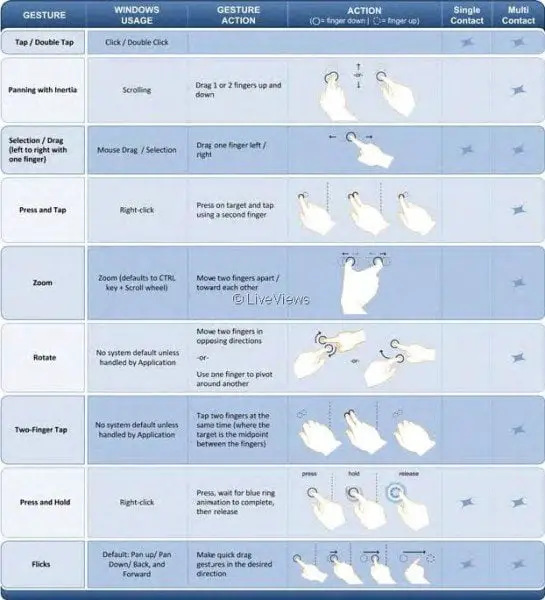Touch Gestures are the basic actions you use to interact with Windows or an application using touch. If you have a touch-enabled monitor and Windows 7 installed, then virtually any program that works with Windows responds to your touch.
My MVP collegue Vasudev has at LiveViews made a nice post about the Touch Gestures in Windows 7. Here are the 9 Touch Gestures required for Multi-touch magic in Windows 7:

Tap and Double-tap – This is the most basic touch action. This is what a click and Double click does. Works everywhere.
Panning with Inertia – This is for scrolling. Drag any part of page up or down with one or more fingers. “You’ll notice details that make this a more natural interaction: the inertia if you toss the page and the little bounce when the end of the page is reached”. This works in most applications that use standard scrollbars.
Selection /Drag –This is like mouse drag and selection. Touch and slide your finger on screen. This moves icons around the desktop, moves windows, selects text (by dragging left or right), etc. Works everywhere.
Press and Tap with second finger – This is like right click. Press on target and tap using second finger. Works everywhere.
Zoom – This is same as CTRL key + Scroll wheel. Pinch two fingers together or apart to zoom in or out on a document. Useful for photos or reading documents on a small laptop. Works in applications that support mouse wheel zooming.
Rotate – Touch two spots on a digital photo and twist to rotate it just like a real photo. Move two fingers in opposite direction or use one finger to pivot around another. Applications need to add code to support this.
Two-finger Tap – Tapping with two fingers simultaneously zooms in about the center of the gesture or restores to the default zoom – great for zooming in on hyperlinks. Applications need to add code to support this.
Press and Hold – Same as Right Click. Hold your finger on screen for a moment and release after the animation to get a right-click. This works everywhere. Same as the other Gesture of Press and Tap with Second finger.
Flicks – Flick left or right to navigate back and forward in a browser and other apps. This works in most applications that support back and forward. This is also very natural gestures when one wants to flick.
These Gestures are built into the core of Windows. They are designed to work with all applications, even the ones that were never designed with touch in mind.
Leave a Reply